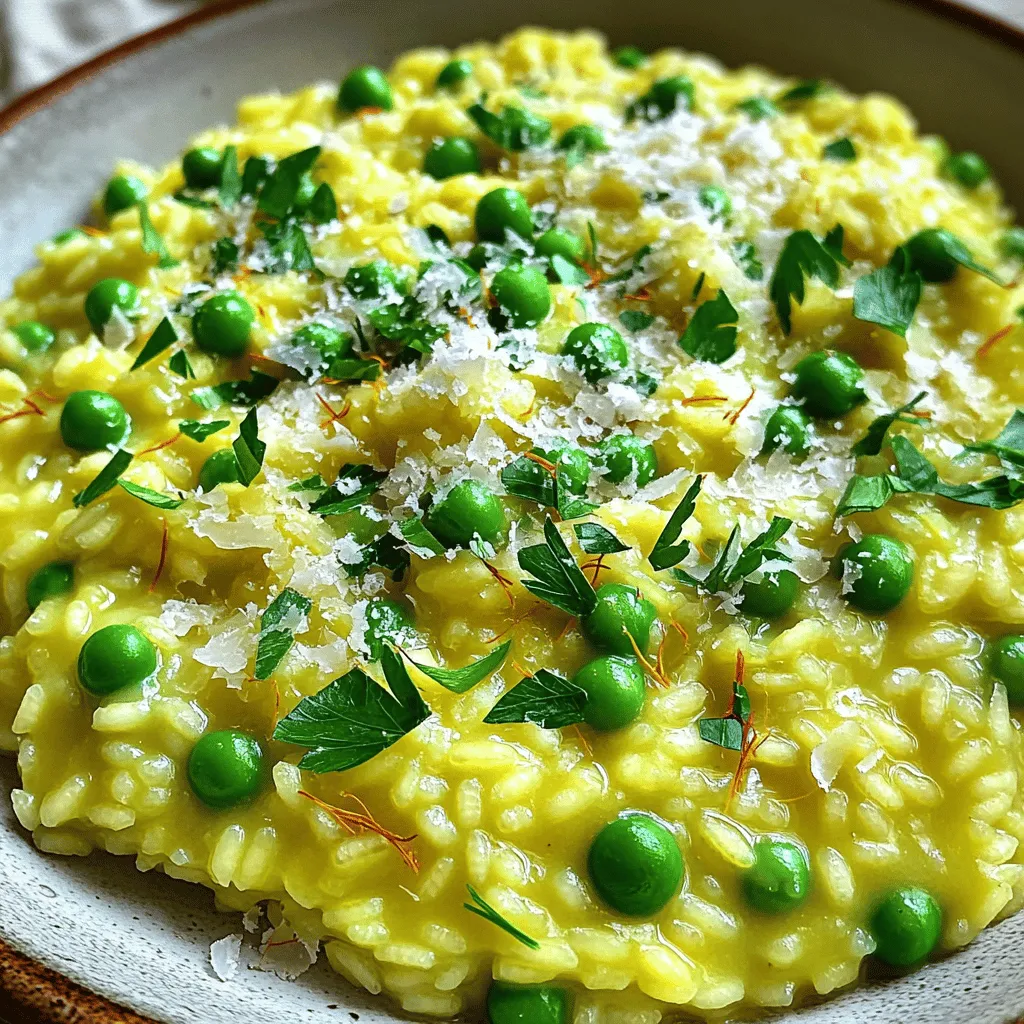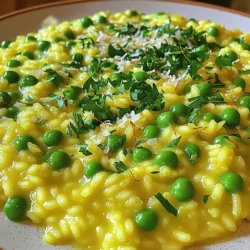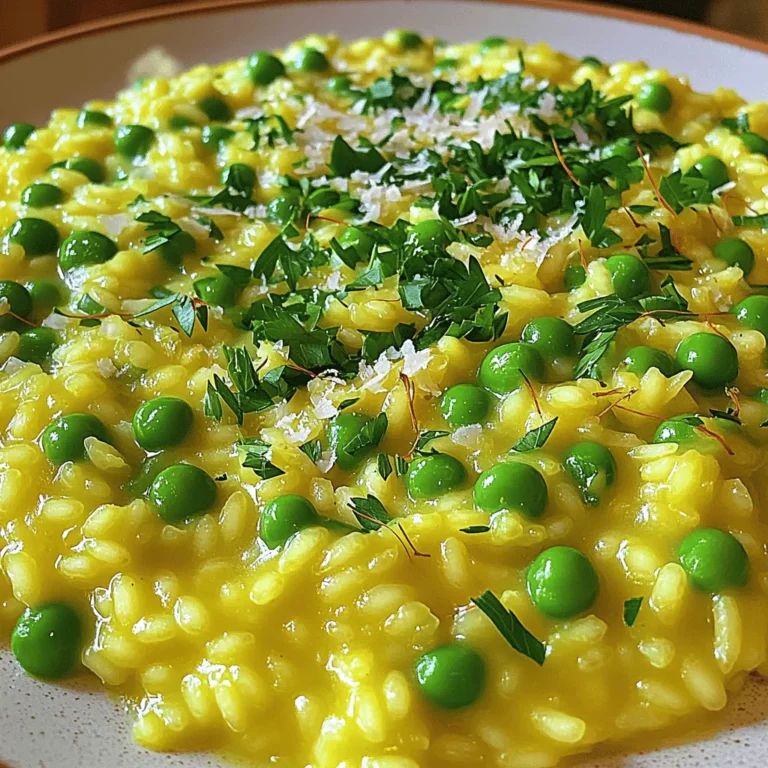If you’re craving a creamy, savory dish, you’re in for a treat! My Saffron Risotto with Peas is not just a meal; it’s a comforting delight that brings warmth to any table. With simple ingredients like fresh peas and fragrant saffron, you can create a dish that impresses both family and friends. Let’s dive into this easy recipe and enjoy making risotto that bursts with flavor and creaminess!
Ingredients
List of Essential Ingredients
To make saffron risotto with peas, gather these key ingredients:
– 1 cup Arborio rice
– 4 cups vegetable broth
– 1 small onion, finely chopped
– 2 tablespoons olive oil
– 1 tablespoon unsalted butter
– 1/2 cup frozen peas, thawed
– 1/4 teaspoon saffron threads
– 1/2 cup grated Parmesan cheese (optional)
– Salt and pepper to taste
– Fresh parsley, chopped (for garnish)
Suggested Ingredient Substitutions
If you lack any of the main ingredients, I have some great swaps:
– Arborio rice can be replaced with Carnaroli rice.
– Vegetable broth can be swapped with chicken broth for a richer flavor.
– Use shallots instead of onion for a sweeter taste.
– For a vegan option, skip the butter and cheese or use vegan alternatives.
Importance of Fresh Ingredients
Using fresh ingredients makes a big difference in flavor. Fresh peas offer sweetness, while a fresh onion adds depth. Quality saffron gives the dish its lovely aroma and golden hue. Always choose the best you can find. Investing in fresh ingredients helps you create a risotto that shines on the plate and tastes divine.
Step-by-Step Instructions
Preparing the Broth
First, grab a small saucepan. Pour in 4 cups of vegetable broth. Heat it over medium heat until it simmers. Keep the broth warm on low heat. This helps the rice cook evenly.
Sautéing the Onion
Next, take a large sauté pan. Add 2 tablespoons of olive oil and 1 tablespoon of unsalted butter. Heat it over medium heat. Once the butter melts and foams, add 1 small, finely chopped onion. Sauté for about 5 minutes. You want the onion to be soft and translucent.
Toasting the Rice
Now, add 1 cup of Arborio rice to the pan. Stir well to coat the rice with the onion mixture. Toast the rice for about 2 to 3 minutes. This allows the rice to absorb flavors and get slightly golden.
Infusing the Saffron
In a ladle, combine 1/4 teaspoon of saffron threads with a few tablespoons of the warm broth. Let it steep for about 5 minutes. This releases the saffron’s color and flavor.
Cooking the Risotto
Pour in one ladle of warm broth to the rice. Stir constantly. Wait until the liquid is mostly absorbed. This step creates the creamy texture you want in risotto. Repeat this process, adding one ladle of broth at a time. Stir often. This should take about 18 to 20 minutes.
Incorporating the Peas and Final Touches
With 5 minutes left, add in 1/2 cup of thawed peas and the saffron-infused broth. Stir gently to mix everything. Once done, remove the pan from heat. If you like, stir in 1/2 cup of grated Parmesan cheese. Season with salt and pepper to taste. Let the risotto sit off the heat for a couple of minutes. This helps the flavors meld nicely.
Tips & Tricks
How to Achieve Perfect Creaminess
To make your saffron risotto creamy, stir often. Stirring releases starch from the rice. This starch is key for that rich texture. Use a wooden spoon for best results. Always add broth one ladle at a time. Wait until the liquid is mostly gone before adding more. This slow process helps the rice absorb flavors and creates creaminess.
Common Mistakes to Avoid
Watch out for these common pitfalls. First, don’t add all the broth at once. This can lead to uneven cooking. Next, avoid high heat. Cooking too fast can burn the rice. Lastly, don’t skip the resting time. Letting the risotto sit a few minutes helps the flavors blend. These steps ensure a dish that’s both tasty and smooth.
Cooking with Saffron: Best Practices
Saffron is delicate and needs care. Always steep saffron in warm broth. This step helps release its color and flavor. Use just a pinch; it’s strong and expensive. Make sure to add it early in the cooking process. This allows the saffron to infuse throughout the dish. If you need more saffron flavor, try adding a bit more later. Just remember, a little goes a long way.

Variations
Adding Proteins (Chicken, Shrimp, etc.)
You can easily boost your saffron risotto with proteins. Chicken or shrimp works great. For chicken, use diced breast meat. Sauté it before adding the onion. For shrimp, add it in the last few minutes. Cook until they turn pink. This adds lovely flavor and makes the dish heartier.
Vegetarian & Vegan Options
If you want a vegetarian or vegan risotto, skip the cheese and use vegetable broth. You can add more veggies like mushrooms or asparagus. These add color and texture. You can also use nutritional yeast to add a cheesy flavor without dairy. This keeps it light and fresh.
Flavor Enhancements (Herbs, Spices, etc.)
Herbs and spices can take your risotto to the next level. Fresh basil or thyme adds brightness. Stir these in at the end for a fresh taste. If you like heat, a pinch of red pepper flakes works well too. You can also try adding lemon zest for a zesty twist. These small changes make a big difference.
Storage Info
How to Store Leftover Risotto
To keep leftover risotto fresh, place it in an airtight container. Let it cool first to avoid steam buildup, which can make it soggy. Store it in the fridge for up to three days. If you want to keep it longer, freezing is a good option.
Reheating Tips for Best Texture
When you reheat risotto, add a splash of broth or water. This helps restore its creamy texture. Heat it slowly in a pan over medium heat, stirring frequently. You can also use a microwave, but add liquid and cover it loosely. Stir halfway through to ensure even heating.
Freezing Risotto: What to Know
Freezing risotto is possible, but it may change the texture. For best results, freeze it right after cooling. Use freezer-safe containers or bags. When ready to eat, thaw overnight in the fridge. Reheat with added broth for the best results. Enjoy your creamy saffron risotto with peas!
FAQs
What is the best type of rice for risotto?
The best rice for risotto is Arborio rice. This rice has high starch content. It helps create a creamy texture. You can also use Carnaroli or Vialone Nano rice. Both types work well for risotto. They absorb flavors and release starch, making your dish rich.
Can I make saffron risotto ahead of time?
You can make saffron risotto ahead of time, but it may lose creaminess. If you do, cook it until just al dente. Let it cool and store it in the fridge. When ready to serve, reheat it slowly. Add a bit of broth or water to restore creaminess.
How can I make risotto in a rice cooker?
To make risotto in a rice cooker, start by sautéing onion and rice in a pan. Then, transfer to the rice cooker. Add broth and saffron. Set it to cook. Stir occasionally. This helps mimic the traditional method. You will still get a creamy risotto.
Does saffron risotto freeze well?
Saffron risotto does not freeze well. Freezing can change its texture. The rice may become mushy when thawed. If you must freeze it, put it in an airtight container. Use within one month for the best taste. Reheat slowly, adding broth to restore creaminess.
To make great saffron risotto, use fresh ingredients and follow careful steps. We covered key ingredients, tips for creamy texture, and delicious variations. Remember, practice makes perfect. Keep these tips in mind for cooking, storing, and reheating. Enjoy your delicious risotto creation! You’ll impress family and friends with your skills.


